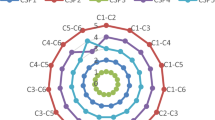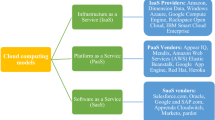Abstract
Generalized spherical fuzzy number (GSFN) is an extension of spherical fuzzy number (SFN) which deals the uncertainties involved in the real-life problems in much better way than other fuzzy numbers. So far, some fundamental operational laws of GSFNs are characterized, yet excluding the logarithmic operation. In this manuscript, we have defined and discussed various algebraic properties of logarithmic operational law (LOL) for GSFN where the logarithmic base \(\delta \) is a positive real number. Moreover, we have developed weighted averaging and weighted geometric aggregation operators and utilize these aggregation operators to initiate a multi-criteria group decision making (MCGDM) technique in the generalized spherical fuzzy (GSF) environment, which has been used to solve a problem of cloud service management. We have indicated the utility and reliability of the proposed MCGDM technique through sensitivity analysis. Finally, a comparative study has been presented with the help of a real data set to justify the rationality and efficiency of our proposed method with the existing methods.







Similar content being viewed by others
References
Zadeh LA (1965) Fuzzy sets. Inf Control 8(5):338–353
Atanassov K (1986) Intuitionistic fuzzy sets. Fuzzy Sets Syst 20:87–96
Chakraborty A, Mondal SP, Ahmadian A, Senu N, Dey D, Alam S, Salahshour S (2019) The pentagonal fuzzy number: its different representations. Prop Rank Defuzzification Appl Game Prob Symm 11(2):248–277. https://doi.org/10.3390/sym11020248
Maity S, Chakraborty A, De SK, Mondal SP, Alam S (2020) A comprehensive study of a backlogging EOQ model with nonlinear heptagonal dense fuzzy environment. Rairo Oper Res 54(1):267–286. https://doi.org/10.1051/ro/2018114
Garg H (2016) A new generalized improved score function of interval-valued intuitionistic fuzzy sets and applications in expert systems, Appl. Soft Comput 38:988–999
Xu ZS (2007) Intuitionistic fuzzy aggregation operators. IEEE Trans Fuzzy Syst 15:1179–1187
Xu ZS, Yager RR (2006) Some geometric aggregation operators based on intuitionistic fuzzy sets. Int J Gen Syst 35:417–433
Gou XJ, Xu ZS (2017) Exponential operations for intuitionistic fuzzy numbers and interval numbers in multi-attribute decision making. Fuzzy Optim Decis Mak 16(2):183–204
Wang Z, Li KW, Wang W (2009) An approach to multiattribute decision making with interval-valued intuitionistic fuzzy assessments and incomplete weights. Inf Sci 179:3026–3040
Garg H (2016) Some series of intuitionistic fuzzy interactive averaging aggregation operators. Springer Plus 5(1):999–1026
Yager RR (2013) Pythagorean fuzzy subsets. In: Proceedings Joint IFSA World Congress and NAFIPS Annual Meeting, Edmonton, Canada, pp 57–61
Yager RR (2014) Pythagorean membership grades in multicriteria decision making. IEEE Trans Fuzzy Syst 22:958–965
Yager RR, Abbasov AM (2013) Pythagorean membeship grades, complex numbers and decision making. Int J Intell Syst 28:436–452
Zhang XL, Xu ZS (2014) Extension of TOPSIS to multi-criteria decision making with Pythagorean fuzzy sets. Int J Intell Syst 29:1061–1078
Garg H (2016) A new generalized Pythagorean fuzzy information aggregation using Einstein operations and its application to decision making. Int J Intell Syst 31(9):886–920
Garg H (2017) Generalized Pythagorean fuzzy geometric aggregation operators using Einstein t-norm and t-conorm for multicriteria decision-making process. Int J Intell Syst 32(6):597–630
Ren PJ, Xu ZS, Gou XJ (2016) Pythagorean fuzzy TODIM approach to multi-criteria decision making, Appl. Soft Comput 42:246–259
Abbas SZ, Khan MSA, Abdullah S, Suna H, Hussain F (2019) Cubic Pythagorean fuzzy sets and their application to multi-attribute decision making with unknown weight information. J Intell Fuzzy Syst 37:1529–1544. https://doi.org/10.3233/JIFS-18382
Ejegwa PA (2019) Pythagorean fuzzy set and its application in career placements based on academic performance using max-min-max composition. Complex Intell Syst 5:165–175. https://doi.org/10.1007/s40747-019-0091-6
Xiao F, Ding W (2019) Divergence measure of Pythagorean fuzzy sets and its application in medical diagnosis. Appl Soft Comput J 79:254–267
Ma ZM, Xu ZS (2016) Symmetric Pythagorean fuzzy weighted geometric/averaging operators and their application in multicriteria decision-making problems. Int J Intell Syst 31(12):1198–1219
Garg H (2018) Linguistic Pythagorean fuzzy sets and its applications in multiattribute decision-making process. Int J Intell Syst 33(6):1234–1263
Yang MS, Hussain Z (2018) Fuzzy entropy for pythagorean fuzzy sets with application to multicriterion decision making. Hindawi Complex 2018:1–14. https://doi.org/10.1155/2018/2832839
Abdullah L, Goh P (2019) Decision making method based on Pythagorean fuzzy sets and its application to solid waste management. Complex Intell Syst 5:185–198. https://doi.org/10.1007/s40747-019-0100-9
Verma R, Merigó JM (2019) On generalized similarity measures for Pythagorean fuzzy sets and their applications to multiple attribute decision-making. Int J Intell Syst 43(10):2556–2583. https://doi.org/10.1002/int.22160
Zhou F, Chen TY (2019) A novel distance measure for pythagorean fuzzy sets and its applications to the technique for order preference by similarity to ideal solutions. Int J Comput Intell Syst 12(2):955–969. https://doi.org/10.2991/ijcis.d.190820.001
Mahmood T, Ullah K, Khan Q, Jan N (2019) An approach toward decision-making and medical diagnosis problems using the concept of spherical fuzzy sets. Neural Comput Appl 31:7041–7053. https://doi.org/10.1007/s00521-018-3521-2
Gündogdua FK, Kahramana C (2019) Spherical fuzzy sets and spherical fuzzy TOPSIS method. J Intell Fuzzy Syst 36(1):337–352. https://doi.org/10.3233/JIFS-181401
Jin H, Ashraf S, Abdullah S, Qiyas M, Bano M, Zeng S (2019) Linguistic spherical fuzzy aggregation operators and their applications in multi-attribute decision making problems. Mathematics 7:413–435. https://doi.org/10.3390/math7050413
Ullah K, Garg H, Mahmood T, Jan T, Ali Z (2020) Correlation coefficients for T-spherical fuzzy sets and their applications in clustering and multi-attribute decision making. Soft Comput 24:1647–1659. https://doi.org/10.1007/s00500-019-03993-6
Ashraf S, Abdullah S, Mahmood T, Ghani F, Mahmood T (2019) Spherical fuzzy sets and their applications in multi-attribute decision making problems. J Intell Fuzzy Syst 36(3):2829–2844. https://doi.org/10.3233/JIFS-172009
Ashraf S, Abdullah S (2019) Spherical aggregation operators and their application in multi-attribute group decision making. Int J Intell Syst 34(3):493–523
Ashraf S, Abdullah S, Mahmood T (2018) GRA method based on spherical linguistic fuzzy Choquet integral environment and its application in multi-attribute decision-making problems. Math Sci 12:263–275. https://doi.org/10.1007/s40096-018-0266-0
Liu P, Zhu B, Wang P, Shen M (2020) An approach based on linguistic spherical fuzzy sets for public evaluation of shared bicycles in China. Eng Appl Artif Intell 87:1–15
Haque TS, Chakraborty A, Mondal SP, Alam S (2020) A new approach to solve multi-criteria group decision making problems by exponential operational law in generalised spherical fuzzy environment. CAAI Trans Intell Technol 5(2):106–114. https://doi.org/10.1049/trit.2019.0078
Li Z, Wei F (2017) The logarithmic operational laws of intuitionistic fuzzy sets and intuitionistic fuzzy numbers. J Intell Fuzzy Syst 33:3241–3253
Garg H (2019) New logarithmic operational laws and their aggregation operators for Pythagorean fuzzy set and their applications. Int J Intell Syst 34:82–106
Garg H (2018) Nancy, new logarithmic operational laws and their applications to multiattribute decision making for single-valued neutrosophic numbers. Cogn Syst Res 52:931–946. https://doi.org/10.1016/j.cogsys.2018.09.001
Mukherjee P, Pattnaik PK, Swain T, Datta A (2019) Task scheduling algorithm based on multi criteria decision making method for cloud computing environment: TSABMCDMCCE. Open Comput Sci 9:279–291
Büyüközkan G, Göçer F, Feyzioğlu O (2018) Cloud computing technology selection based on interval-valued intuitionistic fuzzy MCDM methods. Soft Comput 22(15):5091–5114. https://doi.org/10.1007/s00500-018-3317-4
Rehman ZU, Hussain OK, Hussain FK (2012), Iaas cloud selection using MCDM methods. In: Proceedings of 2012 IEEE Ninth International Conference on e-Business Engineering, Hangzhou, pp 246–251 https://doi.org/10.1109/ICEBE.2012.47.
Youssef AE (2020) An integrated MCDM approach for cloud service selection based on TOPSIS and BWM. IEEE Access 8:71851–71865. https://doi.org/10.1109/ACCESS.2020.2987111
Khan S, Abdullah S, Abdullah L, Ashraf S (2019) Logarithmic aggregation operators of picture fuzzy numbers for multi-attribute decision making problems. Mathematics 7(7):608. https://doi.org/10.3390/math7070608
Jin Y, Ashraf S, Abdullah S (2019) Spherical fuzzy logarithmic aggregation operators based on entropy and their application in decision support systems. Entropy 21:628–663. https://doi.org/10.3390/e21070628
Li Y, Liu P, Chen Y (2016) Some single valued neutrosophic number heronian mean operators and their application in multiple attribute group decision making. Informatica 27(1):85–110
Acknowledgements
In this article, the study of Tipu Sultan Haque is funded by Council of Scientific & Industrial Research (CSIR), India (File no.-08/003(0136)/2019-EMR-I).
Author information
Authors and Affiliations
Corresponding author
Ethics declarations
Conflict of interest
The authors have no conflict of interest in this research paper.
Additional information
Publisher's Note
Springer Nature remains neutral with regard to jurisdictional claims in published maps and institutional affiliations.
Rights and permissions
Springer Nature or its licensor (e.g. a society or other partner) holds exclusive rights to this article under a publishing agreement with the author(s) or other rightsholder(s); author self-archiving of the accepted manuscript version of this article is solely governed by the terms of such publishing agreement and applicable law.
About this article
Cite this article
Haque, T.S., Chakraborty, A. & Alam, S. A novel scheme to detect the best cloud service provider using logarithmic operational law in generalized spherical fuzzy environment. Knowl Inf Syst 65, 3695–3724 (2023). https://doi.org/10.1007/s10115-023-01873-y
Received:
Revised:
Accepted:
Published:
Issue Date:
DOI: https://doi.org/10.1007/s10115-023-01873-y




